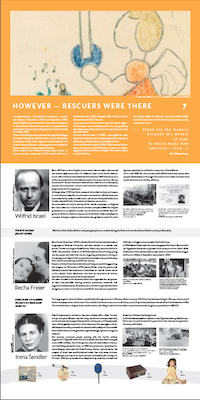About the exhibition
 The exhibition is project of the Claims Conference and was realized by the “Agency for Historical, Civic and Media Education” in cooperation with the “Pedagogical center of the Fritz Bauer Institute” and Centrum Judaicum. The panels were exhibited for the first time in Berlin, Centrum Judaicum, in August 2014 during the 26th Conference of the World Federation of Jewish Child Survivors, their first gathering in Germany. The exhibition consists of ten exhibition panels, a printed brochure and this website.
The exhibition is project of the Claims Conference and was realized by the “Agency for Historical, Civic and Media Education” in cooperation with the “Pedagogical center of the Fritz Bauer Institute” and Centrum Judaicum. The panels were exhibited for the first time in Berlin, Centrum Judaicum, in August 2014 during the 26th Conference of the World Federation of Jewish Child Survivors, their first gathering in Germany. The exhibition consists of ten exhibition panels, a printed brochure and this website.
Parallel to the exhibition the first-ever symposium of Jewish Child survivors was held in Berlin on August 27th at Centrum Judaicum. “Lost Childhood. Jewish Childhood Survivors” was organized by the Claims Conference in cooperation with the World Federation of Jewish Child Survivors of the Holocaust and Descendants (WFJCSD) and the Center of Organizations of Holocaust Survivors in Israel. Internationally recognized experts provided a broad picture of the special suffering of Jewish children during the Holocaust and shed light on the particular situation of child survivors today. Witnesses who survived the Holocaust as children shared their experiences and spoke about their life after the Holocaust.
 Hiding and Ghetto
Hiding and Ghetto
The different circumstances of persecution, which are separately displayed in the exhibition, often overlapped. For example, surviving in hiding meant using a false name. It was unusual to be able to survive in a single hiding place; the impact caused by persecution and the threat of being denounced made it necessary for example to alternate between hiding and the ghetto or false identity.
Concentration camps
Survival was also always a matter of pure luck. »I thank my life to a succession of merciful coincidences«, is what György Konrád, born 1933, says, speaking for others, in his autobiographically based novel «Glück« (Luck). That also applies to those who survived the concentration camps and to the children who were able to reach a precarious safety through rescue actions such as the now well-known children’s transports.
Rescuers
One thing appears certain: no matter where, in what conditions and irrespective of how they behaved, it was only possible for children to survive with the help of other people. Now, unlike then, we are becoming aware of the individual »silent heroines and heroes«. Their commitment automatically raises the question of all that might have been possible but was not done.
 Continuing struggle to survive the survival
Continuing struggle to survive the survival
Many child survivors lived a long life, with ups and downs, determined by personal and family achievements, by setbacks and loneliness and by the fact that their history was suppressed, individually or socially. Often child survivors did not notice the effects of the shades of the past until their old age: this goes hand in hand with recent academic investigation of the trauma suffered.
Here and now
The trauma can bring in its wake different needs as well as requirements and assistance of a social and psychological nature; or it can result in self organization where as active people the child survivors make their fate known to the public. This exhibition also wants to contribute to this.

